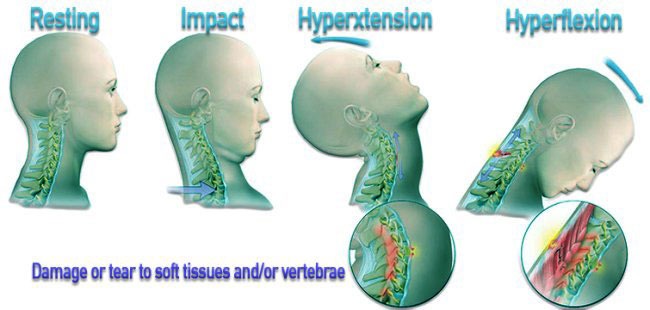What does it mean to have whiplash?
About 70% of adults will have an incidence of neck pain during their lifespan.
Whiplash or whiplash-associated disorders (WAD) refers to necks strains that usually occur with a sudden backwards then forward movement of the head. This sudden movement places high amounts of stress through the muscles, ligaments and discs of the neck.
Whiplash often occurs in rear-end collisions whilst driving, or with high impact sport such as rugby or martial arts. This often results in pain and disability which limits daily activity or work, causing significant physical and emotional burden.
How long does whiplash take to develop?
Symptoms usually appear within 24 hours after the incident which caused the whiplash. Sometimes, symptoms may develop after a few days.
What are the signs & symptoms of Whiplash?
Whiplash is associated with a range of impairments and disabilities.
These may include pain, tenderness and stiffness of the neck with associated muscles spasms.
More severe whiplash may result in neurological symptoms such as numbness or tingling or weakness in your shoulders, arms, or legs.
As the blow that caused the neck strain may sometimes cause a concussion, headaches, balance issues, and even cognitive and emotional dysfunction may occur.
How is Whiplash diagnosed?
Your health professional will ask you appropriate questions about your injury, such as how it occurred, location and severity of pain. This may be accompanied by a physical examination assessing severity and distribution of pain, assessing range of motion and muscle function, and appropriate neurological and other screening tests.
Diagnostic imaging such as CT scans and MRI may help rule out serious pathology.
How long does it take for whiplash to go away?
It is generally accepted that up to 50% of individuals with whiplash injuries will fully recover, while the remaining 50% will continue to experience symptoms to some degree. Many of those who do not recover will have persisting or recurring episodes of pain.
If recovery occurs, it tends to happen within the first 3 months of injury, with little improvement after this period.
How do I know if I will recover well after Whiplash or WAD?
Some predictors of poor outcome are:
- High initial pain intensity and disability
- Duration since the initial onset of pain
- Greater number of affected body parts
- Cold sensitivity
- Post-injury psychological distress
- Passive coping styles and
- History of previous neck pain.
What is the best treatment for whiplash?
An early physiotherapy treatment helps to reduce the physical and emotional burden of whiplash. Research shows that physiotherapy treatment results in significant improvements in symptoms, stiffness and neck function in the short and medium term, compared to the traditional rest or ‘wait and see’ approach.
Recommended physiotherapy treatments include:
- Activity modifications to optimise recovery
- Manual therapy including manipulation
- Dry needling
- Kinesio-taping
- Advice on staying active
- Exercise program incorporating range of motion, low load isometric, postural endurance and strengthening exercises
- For more severe cases of whiplash, your physician may order prescription painkillers and/or muscle relaxants.
- Massage can help to relax some of the tightened muscles.
Hints for self-management
- Over the counter pain relievers
- Initially, ice can be used to reduce pain and inflammation
- After the first few days heat can be used to relax tight muscles prior to performing a range of movement exercise.
Interesting facts
Women are more likely to experience whiplash type injury, this is thought to be due to differences in strength between genders.
More information
If the pain spreads down your arms or you experience numbness, tingling, or weakness in your hands or arms, contact your physician.
Severity
The Québec Task Force (QTF) established four grades of whiplash injury:
- Grade 1 – neck complaints of pain, stiffness or tenderness only but no physical signs noted by examining physician
- Grade 2 – neck complaints and the examining physician finds decreased range of movement and point tenderness in the neck
- Grade 3 – neck complaints with neurological signs such as decreased deep tendon reflexes, weakness, and changes in sensation
- Grade 4 – neck complaints and fracture, dislocation or injury to the spinal cord
How to prevent whiplash?
As the majority of whiplash happens with rear-end collisions, the most effective way to prevent whiplash injuries is to have a properly designed seat with a well rated head restraint.
As previous whiplash injuries have shown to predict the risk of recurrent injuries, proper initial treatment with a patient-specific rehabilitation program is very important.
Research suggests that improvements in specific neck musculature strength, deep neck control and cervical range of motion may help reduce the risk of whiplash.
If you have any questions about Whiplash or Whiplash Associated Disorders contact the team at Sydney Physiotherapy Solutions on 9252 5770 or www.sydneyphysiosolutions.com.au


